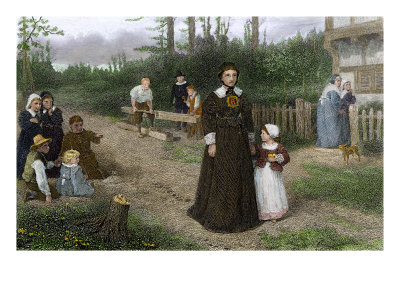In chapter 6 of the Scarlet Letter, the infant which Hester Prynne constantly carries around, finally has its name and character fully revealed. In fact, we find out that the infant is a girl by the name of Pearl. Pearl, as previously stated in my other blog post, serves as an indicator of Hester Prynne’s emotions and conscience. However, after reading this chapter, we can come to the conclusion that the child is not only a symbol of Hester’s conscience, but a form of insubordination against the Puritans and their lifestyle.
Chapter 6, (titled “Pearl”), contains multiple pieces of evidence which suggest that Pearl is a symbol for rebellion:
1. “But little Pearl was not clad in rustic weeds. Her mother, with a morbid purpose that may be better understood hearafter, had bought the richest tissues that could be procured, and allowed her imaginative faculty its full play in the arrangement and decoration of the dresses which the child wore, before the public eye.”
This excerpt is the first of many examples of why the child could mean much more than just a human being, or daughter, to Hester Prynne. Unlike the Puritans and their children who dressed in drab, black, humbling clothing trying to achieve “salvation” in vain, Mistress Prynne clothed her little girl in the most expensive garments. It is obvious that through this, she is in a way defying and reproaching the Puritans and their hypocritical customs.
2. “The discipline of the family, in those days, was of a far more rigid kind than now. The frown, the harsh rebuke, the frequent application of the rod, enjoined by Scriptural authority, were used, not merely in the way of punishment for actual offenses, but as a wholesome regimen for the growth and promotion of all childish virtues. Hester Prynne, nevertheless, the lonely mother of this one child, ran little risk of erring on the side of undue severity.”
The Puritans were well known for applying corporal punishment as a”necessary” way for raising their children, and evidently Hester Prynne disapproved of this type of upbringing. Strongly disliking the cruelty and strictness of Puritans towards their children, she chooses that she will not raise her child with the aid of violence. This is yet another instance of Pearl being an example of Mistress Prynne’s defiance of Puritan authority.
3. “And then what a happiness would it have been, could Hester Prynne have heard her clear, bird-like voice mingling with the uproar of other childish voices, and have distinguished and unrabeled her own darling’s tones, amid all the entangled outcry of a group of sportive children! But this could never be.”…”She saw the children of the settlement, on the grassy margin of the street, or at the domestic thresholds, disporting themselves in such grim fashions as the Puritanic nurture would permit; playing at going to church, perchance; or at scourging Quakers; or taking scalps in a sham-fight with the Indians; or scaring one another with freaks of imitative witchcraft.”
“Her one baby-voice served a multitude of imaginary personages, old and young, to talk withal. The pine-trees, aged, black, and solemn, and flinging groans and other melancholy utterances on the breeze, needed little transformation to figure as Puritan elders; the ugliest weeds of the garden were their children, whom Pearls smote down and uprooted most unmercifully.”
In other words, Hester Prynne did not allow Pearl to interact with the Puritan children, because she viewed them as vengeful beings; as the carriers of Puritanistic ideals which she strongly loathed. There was no need for the mother to force her daughter to stay at home, as Pearl sturdily disliked the Puritan children anyway. Instead of going outside to play with the Puritan boys and girls, she stayed around her home’s premises and played all by herself. One of her pastimes included interacting with inanimate objects such as pine-trees and weeds in the garden; she imagined the trees as vicious Puritans and the weeds as their young descendants. This is in no doubt, another sign of Pearl being a representation of Prynne’s hate and resistance against the Puritans.
After reading almost half of The Scarlet Letter, it becomes evident that Pearl is much more than just a static personage, as she carries multiple hidden symbols along with her character traits. What do you think that Pearl symbolizes?

i see where you are coming from. i never really thought of Pearl that way, i always thought she just an accident who just happens to pay the price with her mothers reckless behavior.